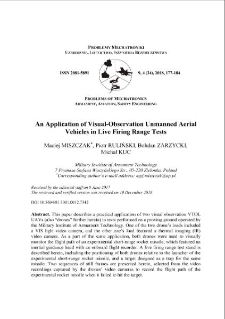Nasza Biblioteka Cyfrowa udostępnia 1 868 obiektów cyfrowych
Obiekt
Tytuł: An Application of Visual-Observation Unmanned Aerial Vehicles in Live Firing Range Tests ; An Application of Visual-Observation Unmanned Aerial Vehicles in Live Firing Range Tests
Tytuł odmienny:
Zastosowanie obserwacyjnych, bezzałogowych statków powietrznych do badań poligonowych ; Zastosowanie obserwacyjnych, bezzałogowych statków powietrznych do badań poligonowych
Współtwórca:
Piotr RULIŃSKI, Bohdan ZARZYCKI, Michał KUC ; Piotr RULIŃSKI, Bohdan ZARZYCKI, Michał KUC
Abstrakt:
This paper describes a practical application of two visual observation VTOL UAVs (also “drones” further herein) in tests performed on a proving ground operated by the Military Institute of Armament Technology. One of the two drone’s loads included a VIS light video camera, and the other one’s load featured a thermal imaging (IR) video camera. As a part of the same application, both drones were used to visually monitor the flight path of an experimental short-range rocket missile, which featured an inertial guidance head with an onboard flight recorder. A live firing range test stand is described herein, including the positioning of both drones relative to the launcher of the experimental short-range rocket missile, and a target designed as a trap for the same missile. Two sequences of still frames are presented herein, selected from the video recordings captured by the drones’ video cameras to record the flight path of the experimental rocket missile when it failed to hit the target. The VIS video camera observation of the rocket missile’s flight past the target, and especially in the end stage of flight facilitated an approximate determination of the missile’s landing location; the IR camera observation of the same facilitated the precise location of the landed missile in the field. Hence, both drones proved to be tools capable in locating experimental rocket missiles which missed their target and landed in the field of the proving ground.
;
This paper describes a practical application of two visual observation VTOL UAVs (also “drones” further herein) in tests performed on a proving ground operated by the Military Institute of Armament Technology. One of the two drone’s loads included a VIS light video camera, and the other one’s load featured a thermal imaging (IR) video camera. As a part of the same application, both drones were used to visually monitor the flight path of an experimental short-range rocket missile, which featured an inertial guidance head with an onboard flight recorder. A live firing range test stand is described herein, including the positioning of both drones relative to the launcher of the experimental short-range rocket missile, and a target designed as a trap for the same missile. Two sequences of still frames are presented herein, selected from the video recordings captured by the drones’ video cameras to record the flight path of the experimental rocket missile when it failed to hit the target. The VIS video camera observation of the rocket missile’s flight past the target, and especially in the end stage of flight facilitated an approximate determination of the missile’s landing location; the IR camera observation of the same facilitated the precise location of the landed missile in the field. Hence, both drones proved to be tools capable in locating experimental rocket missiles which missed their target and landed in the field of the proving ground.
Miejsce wydania:
Warszawa
;
Warszawa
Wydawca:
Wojskowa Akademia Techniczna ; Wojskowa Akademia Techniczna
Data utworzenia:
Data złożenia:
Data wydania:
Rozmiar:
Identyfikator:
oai:ribes-88.man.poznan.pl:2534
Sygnatura:
DOI 10.5604/01.3001.0012.7342 ; DOI 10.5604/01.3001.0012.7342
ISSN elektroniczny:
ISSN drukowany:
Język:
Właściciel praw:
Wojskowa Akademia Techniczna ; Wojskowa Akademia Techniczna
Strona początkowa:
Strona końcowa:
Tom:
Słowa kluczowe:
external ballistics, drones, missile, firing range, observational cameras ; external ballistics, drones, missile, firing range, observational cameras
Kolekcje, do których przypisany jest obiekt:
Data ostatniej modyfikacji:
18 wrz 2025
Data dodania obiektu:
18 wrz 2025
Liczba wyświetleń treści obiektu:
0
Wszystkie dostępne wersje tego obiektu:
https://ribes-88.man.poznan.pl/publication/2842
Wyświetl opis w formacie RDF:
Wyświetl opis w formacie OAI-PMH:
| Nazwa wydania | Data |
|---|---|
| An Application of Visual-Observation Unmanned Aerial Vehicles in Live Firing Range Tests | 18 wrz 2025 |
Obiekty Podobne
Maciej MISZCZAK Waldemar ŚWIDERSKI, Bohdan ZARZYCKI

